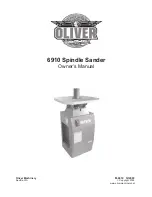
Includes - Foreseen Use, Work Stations, Putting Into Service, Operating,
Dismantling, Assembly and Safety Rules
Operator Instructions
Important
Read these instructions carefully before installing, operating,
servicing or repairing this tool. Keep these instructions in a safe
accessible place.
Manufacturer/Supplier
Product Type
RPM
Cycles Per Min
Model No/Nos
Serial No (if any)
Product Nett Weight
lbs
Kg
Recommended Use Of
Balancer Or Support
Recommended Hose Bore
Size - Minimum
Recommended Max.
Hose Length
Ins
M/M
Ft
M
No
Page No 1
10mm Belt Sander
UT5764
1.72
0.78
3/8
10
30
10
16,000
Universal Air Tool Company Limited
Unit 8
Lane End Industrial Park
High Wycombe
Bucks
HP14 3BY
Work Stations
The tool should only be used as a hand held hand operated tool. It is
always recommended that the tool is used when standing on a solid
floor. It can be used in other positions but before any such use the
operator must be in a secure position having a firm grip and footing and
be aware of the safety rules to be obeyed when using the sander.
Foreseen Use of the Tool
The tool is designed for the purpose of cleaning or sanding of materials
using a continuous abrasive belt. Belts are available in various grades to
suit fine finishing or fast material removal.
Do not use the tool for any other purpose than that for which it was
designed. Do not modify this tool for any other use or for its use as a belt
sander without first consulting the manufacturer or the manufacturer’s
authorised distributor.
Putting Into Service
Air Supply
Use a clean lubricated air supply that
will give a measured air pressure at
the tool of 90 p.s.i./6.3 bar when the
tool is running with the trigger/lever
fully depressed. Use recommended
hose size and length. It is recom-
mended that the tool is connected to
the air supply as shown in figure 1. Do
not connect the tool to the air line sys-
tem without incorporating an easy to
Tel No
Fax No
(01494) 883300
(01494) 883237
reach and operate air shut off valve. The air supply should be lubricated.
It is strongly recommended that an air filter, regulator, lubricator (FRL) is
used as shown in Figure 1 as this will supply clean, lubricated air at the
correct pressure to the tool. Details of such equipment can be obtained
from your supplier. If such equipment is not used then the tool should be
lubricated by shutting off the air supply to the tool, depressurising the
line by pressing the trigger on the tool. Disconnect the air line and pour
into the air inlet a teaspoonful (5ml) of a suitable pneumatic motor lubri-
cating oil preferably incorporating a rust inhibitor. Reconnect tool to air
supply and run tool slowly for a few seconds to allow air to circulate the
oil. If tool is used frequently lubricate on daily basis and if tool starts to
slow or lose power.
It is recommended that the air pressure at the tool whilst the tool is
running is 90 p.s.i./6.3 bar. The tool can run at lower and higher
pressures with the maximum permitted working air pressure of 100
p.s.i./7 bar.
Noise Level
Sound Pressure Level 85.0 dB(A)
Test Method
Tested in accordance with Pneurop
test code PN8NTC1 and ISO Standard 3744
Sound Power Level 96.0 dB(A)
Vibration Level
Test Method
Tested in accordance with ISO
standard 8662/1
Less than 2.5
Metres / Sec²
N/A
Personal Safety Equipment
Use - Safety Glasses
Yes
Use - Safety Gloves
Use - Safety Boots
Use - Breathing Masks
Yes
Use - Ear Protectors
Air Pressure
Recommended Working
6.3
bar
90
PSI
Recommended Minimum
n/a
bar
n/a
PSI
Maximum
7.0
bar
100
PSI






















